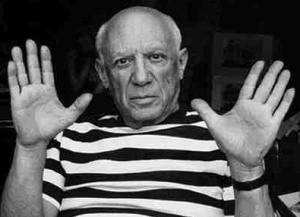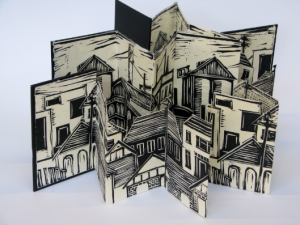By Margueritte Peterson
Ask ten people near you right now who the most famous artist of all time is. I guarantee you (in the way where I can’t really pay up if I’m wrong) that at least half will name Pablo Picasso as the first artist who comes to mind. Picasso, a Spanish painter, sculptor, designer, poet and playwright is commonly regarded as one of the greatest and most daring artists of all time – after all, it is he we can thank for bringing world-wide awareness to the Cubist artistic movement and to the artistry of the collage.
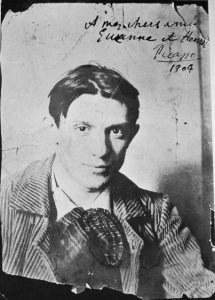 Picasso was born in Malaga, Spain, in 1881, the eldest child of Don Jose Ruiz y Blasco and Maria Picasso y Lopez. Pablo’s father was also a painter, and he specialized in naturalistic representations of different kinds of birds and animals. Growing up, Pablo’s artist father more often than not taught as a professor of art at schools around the country. At a young age Picasso showed artistic talent – in fact, his mother claimed that the boy’s first words were “piz, piz!” for “lapiz” meaning “pencil.” After turning seven Picasso received lessons in drawing and painting from his father, and eventually the family settled in Barcelona, where his father taught at the School of Fine Arts and Pablo thrived in the city’s artistic nature. At the age of 13 Pablo was admitted to the School of Fine Arts after finishing an entrance exam that usually took students a month in just a short week.
Picasso was born in Malaga, Spain, in 1881, the eldest child of Don Jose Ruiz y Blasco and Maria Picasso y Lopez. Pablo’s father was also a painter, and he specialized in naturalistic representations of different kinds of birds and animals. Growing up, Pablo’s artist father more often than not taught as a professor of art at schools around the country. At a young age Picasso showed artistic talent – in fact, his mother claimed that the boy’s first words were “piz, piz!” for “lapiz” meaning “pencil.” After turning seven Picasso received lessons in drawing and painting from his father, and eventually the family settled in Barcelona, where his father taught at the School of Fine Arts and Pablo thrived in the city’s artistic nature. At the age of 13 Pablo was admitted to the School of Fine Arts after finishing an entrance exam that usually took students a month in just a short week.
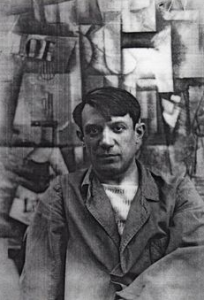 In 1900 Pablo made his first trip to Paris, and while living modestly (and by modestly I mean burning some of his early work to use as fuel for the fire in an apartment only slightly larger than Harry Potter’s cupboard) he first began to develop his range of painting style. Amusingly, Picasso is one of the few painters whose work is separated into periods based on the color scheme of the paintings! (True, his later work is based on style, but still amusing, no?) The Blue Period, the Rose Period, the African-Influence Period… all use obvious factors to group Picasso’s art into a certain “type”. After 1909, Picasso and his friend and fellow artist Georges Braque began an entirely new style of painting that would come to be known as “Cubism”. Cubism was highly stylized, often using neutral tones to highlight contrasting shapes of people and items. These paintings are extremely remarkable and very distinguishable from other styles of painting.
In 1900 Pablo made his first trip to Paris, and while living modestly (and by modestly I mean burning some of his early work to use as fuel for the fire in an apartment only slightly larger than Harry Potter’s cupboard) he first began to develop his range of painting style. Amusingly, Picasso is one of the few painters whose work is separated into periods based on the color scheme of the paintings! (True, his later work is based on style, but still amusing, no?) The Blue Period, the Rose Period, the African-Influence Period… all use obvious factors to group Picasso’s art into a certain “type”. After 1909, Picasso and his friend and fellow artist Georges Braque began an entirely new style of painting that would come to be known as “Cubism”. Cubism was highly stylized, often using neutral tones to highlight contrasting shapes of people and items. These paintings are extremely remarkable and very distinguishable from other styles of painting.
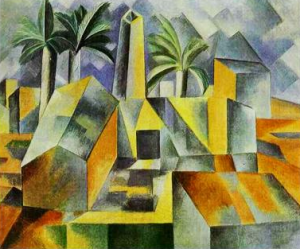 Later on in life, Picasso explored many various types of art, spending quite a bit of time working on sculpture, to the delight of many, and even penning over 300 poems beginning in the 1930s. He moved in Bohemian circles in France for the rest of his life, and by the time of his death he was an international celebrity, often with fans as interested in his personal life (and two wives and four children and various mistresses) as they were in his art! Nevertheless, his art has remained, to this day, wildly popular and unique, and often an inspiration to modern artists.
Later on in life, Picasso explored many various types of art, spending quite a bit of time working on sculpture, to the delight of many, and even penning over 300 poems beginning in the 1930s. He moved in Bohemian circles in France for the rest of his life, and by the time of his death he was an international celebrity, often with fans as interested in his personal life (and two wives and four children and various mistresses) as they were in his art! Nevertheless, his art has remained, to this day, wildly popular and unique, and often an inspiration to modern artists.
Now why are we, as an antiquarian book business, blogging about an artist? Funny you should ask! A. It is good to mix it up from time to time, and B. Artist Books are becoming more and more widely known and collected. Artist Books, not necessarily being books about the artist, but rather artistic forms of expression coinciding with our favorite things… books, are created by many designers around the world who were influenced by Picasso’s modes of expression. Artist Books are works of art in and of themselves, often with designer bindings and hand drawn illustrations within. Often, these “books” are not to be read, but rather to be put on display. These beautiful works are sweeping across the antiquarian book world… and we wished to honor the birthday of one who helped bring modern art into this world, and therefore (a long-shot, but still…) helped allow the Artist Book to exist! Happy Birthday, Pablo Picasso.

